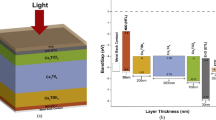Abstract
Hybrid perovskite solar cells emerged recently as cost effective alternative to conventional silicon devices. In this work, we analyze the potential of inorganic materials as hole transport materials in replacement of the expensive Spiro-OMETAD. Key cell factors like efficiency, fill factor, open circuit voltage, and short circuit current were calculated for devices including CuI, CuSCN, NiO, and Cu2O as hole transport materials. Both defect free materials and structures including defect levels have been studied. Defect free n TiO2/CH3NH3PbI3/p-Cu2O structure shows the highest efficiency of around 25%, whereas the efficiency is reduced to 22% in presence of a defect located at 0.45eV above the valance band of Cu2O. The high open circuit voltage (1.13 eV) for p-Cu2O based structure suggests a minimized energy loss due to the charge transfer across the hetero-junctions. The results point out the possibility to develop high efficiency, low cost, and stable perovskite solar cells using Cu2O as HTM.
Access this chapter
Tax calculation will be finalised at checkout
Purchases are for personal use only
Preview
Unable to display preview. Download preview PDF.
Similar content being viewed by others
References
Kojima, A., Teshima, K., Shirai, Y. & Miyasaka, T., “Organometal halideperovskites as visible-light sensitizers for photovoltaic cells”, J. Am. Chem. Soc.131, 6050–6051 (2009).
J. Burschka, et al. Nature 499 (2013) 316.
Jeffrey A. Christians, Raymond C. M. Fung, and Prashant V. Kamat, “An Inorganic Hole Conductor for Organo-Lead Halide Perovskite, Solar Cells. Improved Hole Conductivity with Copper Iodide”, J. Am. Chem. Soc. 2014, 136, 758–764.
Peng Qin, Soichiro Tanaka, Seigo Ito, Nicolas Tetreault, Kyohei Manabe, Hitoshi Nishino, Mohammad KhajaNazeeruddin & Michael Grätzel, “Inorganic hole conductor-based lead halide perovskite solar cells with 12.4% conversion efficiency”, NATURE COMMUNICATIONS | 5:3834 | DOI: 10.1038/ncomms 4834.
Anand S. Subbiah, Ansuman Halder, Soham Ghosh, Neha Mahuli, Gary Hodes, and Shaibal K. Sarkar, “Inorganic Hole Conducting Layers for Perovskite-Based Solar Cells”, dx.doi.org/10.1021/jz500645n|J. Phys. Chem. Lett. 2014, 5, 1748–1753.
Solution-Phase Synthesis of Cu2O Nanocubes, Linfeng Gou and Catherine J. Murphy, Nano Letters, 2003, 3 (2), pp 231–234.
COPPER (I) OXIDE (Cu2O) BASED SOLAR CELLS — A REVIEW, Abdu, Y. and Musa, A.O, Bajopas Volume 2 Number 2 December, 2009.
Electrodeposited ZnO/Cu2O heterojunction solar cells, S.S. Jeong, A. Mittiga, E. Salza, A. Masci, S. Passerini, ElectrochimicaActa 53 (2008) 2226–2231.
Growth of Cu2O thin films with high hole mobility by introducing a low-temperature buffer layer, B.S. Li, K. Akimoto, A. Shen, Journal of Crystal Growth, Volume 311, Issue 4, 1 February 2009, Pages 1102–1105.
Sequential deposition as a route to high-performance perovskite-sensitized solar cells, Julian Burschka, Norman Pellet, Soo-Jin Moon, Robin Humphry-Baker, PengGao, Mohammad K. Nazeeruddin, & Michael Gratzel, NATURE, VOL 499, 18 JULY 2013.
Author information
Authors and Affiliations
Editor information
Editors and Affiliations
Rights and permissions
Copyright information
© 2015 TMS (The Minerals, Metals & Materials Society)
About this paper
Cite this paper
Hossain, M., Alharbi, F., Tabet, N. (2015). Computational Assessment of the Performance of Lead Halide Perovskite Solar Cells Using Inorganic Layers as Hole Transport Materials. In: Karaman, I., Arróyave, R., Masad, E. (eds) Proceedings of the TMS Middle East — Mediterranean Materials Congress on Energy and Infrastructure Systems (MEMA 2015). Springer, Cham. https://doi.org/10.1007/978-3-319-48766-3_35
Download citation
DOI: https://doi.org/10.1007/978-3-319-48766-3_35
Publisher Name: Springer, Cham
Print ISBN: 978-3-319-48599-7
Online ISBN: 978-3-319-48766-3
eBook Packages: Chemistry and Materials ScienceChemistry and Material Science (R0)




